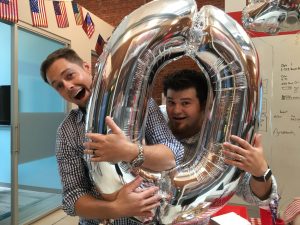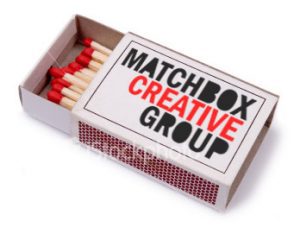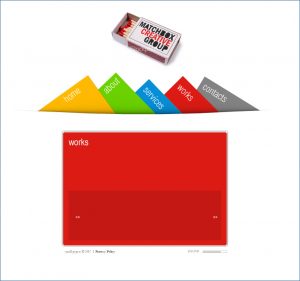On July 1, 2006, Matchbox Design Group was born and now 10 Years of Business later we are alive and well. That was ten years ago to the exact date. On the eve of this joyous occasion — a milestone ten years in the making — owners, Brent Feldman and Cullen Whitmore, take a moment to reflect.

Fun Fact: The original name wasn’t Matchbox Design Group; it was Matchbox Creative Group. Here’s an email chain between Brent and Cullen from 2006 discussing the future logo and name of Matchbox.
Here is a spec of the box with logo – we could do it in black and white on the business card. The reason that I wanted the matchbox the other way is because it focused on the logo and not the matches coming out of it. I think that this will really pop on the website, and if you like it, I can get the full res on and develop it further.
B-rent
 Cullen, who was working for another company at the time while doing freelance work with Brent, responded. Except for this time, he included the future Matchbox website template with his logo version. Again, we’re talking circa 2006 on the world wide web.
Cullen, who was working for another company at the time while doing freelance work with Brent, responded. Except for this time, he included the future Matchbox website template with his logo version. Again, we’re talking circa 2006 on the world wide web.
The boss is taking us out to lunch, but here are my thoughts. I adjusted the colors to match a bit. – Cullen

Once seeing the logo mocked up as a web page, it sparked Brent to see if the domain name was available.
Now that you know the story of how it all started, it’s time to hear from Brent and Cullen — ten years after this email chain about a logo. Brent and Cullen share what they have learned after being through 10 years of business together in St. Louis, MO. Brent Feldman takes on the first five lessons and Cullen Whitmore shares the last five — in their own words.
10 Things I Learned in 10 Years of Business
1) The behind-the-scenes tour of the client’s business is one of the coolest parts of the job.
To know a client’s business, you need to know how they work. When I was a kid I loved the book by David Macaulay, The Way Things Work, and this translated into a love of process and desire to explore. When we get the offer to see the factory floor or engineering room — or basically anywhere you can see things being produced — we gladly accept and ask as many questions as possible.
2) Really rewarding work doesn’t have to come from really big budgets.
We have worked for a handful of non-profit organizations over the years and with each new experience, we gain a new appreciation for what we are able to do for people who do so much. The human element connected to each of these clients helps us remove our B2B or B2C thinking and make an impact on a different level.
In addition, being a business owner means that creating and keeping relationships is one of the most important parts of the job. We have been fortunate enough to help people in their careers by providing employment, finding opportunities to help others get employed or just giving advice.
3) Constant learning is imperative to stay ahead, and it should be fun.
In 2006, Cullen and I planned to offer web design, development, 3-D modeling/rendering, and audio and video services to complete what we believed was a full-service agency offering. 3-D modeling and rendering far outpaced our other services in demand during our first two years until the market crash in 2008. A service that few competitors offered had been rendered obsolete and we were forced to grow and change.
In 2009, we added social media to our service offering. This garnered us clients like Energizer and St. Louis Community Credit Union. We got to bring the Energizer Bunny onto Facebook and helped a Community Development Financial Institution form its social media roots.
Eventually, custom Facebook tabs were deprecated and again we needed to continue to progress. Custom development and branding took a focus when we dealt with some startup companies with very unique and complex needs. The experience of helping to build a client’s brand and product at the same time was priceless.
We continue to learn new development practices, more about what good SEO habits every SEO should possess and web design trends to keep our business healthy and because we like it!
4) Part of the experience has been the amazing relationships we have formed with our clients.
We never knew that when we walked into the Fox Architects office in 2007 that we would be having lunch outings with John Berendzen in 2016. We’ve definitely learned that working for people you like is important because chances you’re going to have to interact with them a lot. For that same reason, when someone you know, respect and work with passes away – it can be like losing a friend.
Over 10 years, I can’t begin to name how many special, interesting and talented people we have had the opportunity to work with and for — and I am deeply thankful for all of them.
5) We have amazing people we work with and are also happy to be a spot on other’s resumes.
Our team is one of our proudest achievements. To assemble a group of people who do great work and are great to work with is no easy task. However, the caliber of people we work with, personally and professionally, are truly second to none.
Hiring is a difficult process because getting the best person for the job isn’t about purely about getting the work done, it’s about communication and trust. Finding people that fit the culture is so important when you have a small close-knit team.
6) Don’t be afraid to say no to a project.
It is incredibly important to learn what your boundaries are and to evaluate each project against them. These could be timeframes, minimum budgets and sometimes even moral boundaries. One of the hardest things to do as a business owner is leaving money on the table, but you have to check yourself to see if you’re compromising your values, pushing these boundaries or putting your team in an unneeded, overly stressful situation.
You also have to take people’s personalities into the equation. If there is something off and you don’t think you’re a good fit, you probably aren’t.
7) Take on the challenge.
Some of our most rewarding projects have been some of our most difficult. We love to take on the challenge when someone says it’s going to be really hard or it can’t be done. Maybe we’re being hard-headed, but there has to be away. At times, it can be nerve-racking because you haven’t built anything like it before. Don’t let that steer you away. It’s time to learn something new and grow as a company.
Not every challenge you take on is going to end well, but the experience you have and the ability to build something like it again is priceless. Use it to help shape those boundaries, goals, budgets, and timeframes for future projects.
8) Learn the importance of personal time and a work/life balance.
As a business owner, it’s hard to turn off that “work” side of your brain. A lot of the reason that we own our business is that we love doing what we do. When we first started, Brent and I used parts of our apartments as our offices. We quickly learned that we couldn’t even get away from work when we wanted to. For us, it was getting an office that helped. We were not only able to separate work from home, but it also gave us a place to grow and bring on new employees.
Over 10 years of business, we’ve seen a lot of agencies and other companies that find themselves constantly working late into the evening and this is something that we decided we never want to become the “norm” for our company.
Now don’t get me wrong, if a deadline is approaching and we need put in overtime, our team is awesome and takes care of it without complaint. But, I think that is a lot in part to the work/life balance we try to put in place. We work 70 hours bi-weekly and every other Friday is a half-day. This gives everyone that much-needed time to recharge, work on their personal projects and live their life outside of the office.
9) Embrace new technology
We are constantly reminded of the quote, “Innovate or die.” In our industry, it couldn’t be truer. When we first started, the cutting-edge tech was using Adobe Flash for your website. (Now it is flat-file CMSs with continuous integration.) We have used more code libraries and services that I can remember. We’re still adding new tools to the mix.
It is important to have the standard way that you design and develop, but try and do at least one thing new for each project. Some of our favorite new tools and services right now are ProsperWorks, Avocode, Zendesk, and Statamic. Give them a look and we would be happy to tell you how we’re using them.
10) Trust your gut.
At the end of the day, you have to trust your gut. Whether it’s trying to price a project, figure out a timeline or have a tough conversation with an employee or client, you never want to be in a situation where you’re playing the “what if” game after the fact.
When you trust your gut, regardless of the outcome, you can stand behind the decision you made, knowing it’s correct. Which is why Matchbox Design Group is still doing great after 10 years of Business in St. Louis, MO.




